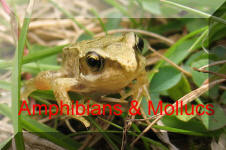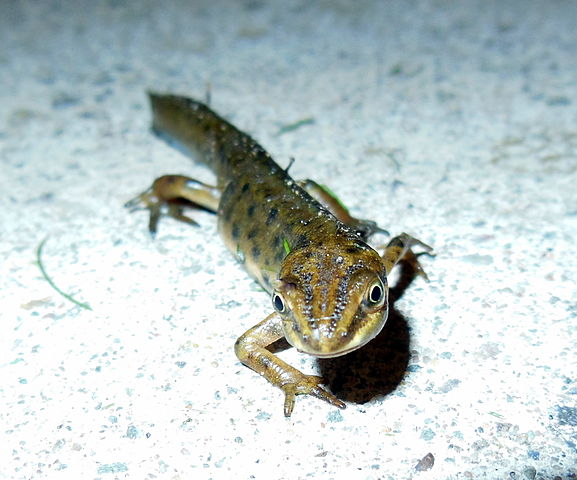BACK TO ..
....
AKA Smooth Newt
Description
Common newts are olive green or pale brown with a bright orange, black spotted underside. In the breeding season males develop a wavy crest from their heads to their tails. They are widespread throughout mainland Britain.
Common newts are nocturnal and spend the day hiding under large stones or compost heaps. From mid-October they hibernate, emerging again in February or March. Males seek out females and entice them by wafting a glandular secretion.
The male drops a packet of sperm (spematophore) near the female, which she collects. A week or so later she lays up to 400 eggs on broadleaved aquatic plants. Eggs are laid individually in a folded pondweed leaf; these hatch out into tadpoles complete with gills for underwater breathing. This phase lasts well into autumn when, with the their lifecycle. The larvae hatch, and during the next 10 weeks change completely, or metamorphose, into juvenile newts.
What does it eat?
On land it eats insects, slugs and worms. In the water they hunt insects, tadpoles, water snails and small crustaceans, such as shrimps.When will I see it?
Usually in the spring and summer.Where will I see a Smooth Newt?
In and around the pond and bog garden. Outside the breeding season also in parks, farmland, woods, wet heathland, bogs and marshes.
The Smooth or Common Newt as it is also known, has the widest distribution of our native newts. They emerge from hibernation in March, they breed through to May and generally the adult newts leave the water in July.
They spend the rest of the summer and winter very close to the breeding pond, hiding in leaf litter, long grass and under stones. This is known as the "terrestrial stage", the males absorb their crests and become more drab in appearance. The newts come out to feed after dark on small invertebrates as they prepare for hibernation in late September.
These newts are very likely to make use of garden ponds and will be most often seen during the aquatic stage, when they will rise to the surface of the pond to gulp air.
Identification
Tailed Amphibian-Smooth velvety skin
Dorsal surface and flanks, Females - light brown colouration with darker spots or speckles.
Males - brown/olive green or tan with black spots
Ventral surface, creamy yellow or orange, black spotting on the belly.
The throat is creamy white and lighter than the belly, usually spotted or speckled.
Length: 10 - 11 cm.
The female newt is light brownish, paler underneath, and the larger male is greyish profusely spotted with black. In spring when the pair have taken up residence in a pond disused well or other freshwater habitat, the male develops a bright orange belly flush with blue and red markings on the tail. A long wavy crest along the back is used to full effect in an elaborate underwater courtship display.Newts, being amphibians, spend the summer in fresh water and hibernate in winter, usually beneath stones. In this state they have been mistaken for lizards but they do not have the hard shiny and scaly skin of the latter. They are also smaller, measuring up to 4in. (10cm), with a vertically flattened tail, 'finned' along its length on both sides.
SexingMales are smaller than females, during the breeding season they develop a wavy crest; continuous from head to tail. Males also have fringing on the hind toes at this time
Eggs
The female deposits her eggs individually on aquatic plants, carefully wrapping each egg in a leaf. It is not possible in the field. to distinguish the eggs of the Smooth Newt from those of the Palmate Newt
What other similar species are they ?
It can be very difficult to distinguish the Smooth Newt from the Palmate Newt (Triturus helveticus). Male smooth newts have a much more developed wavy dorsal crest in the breeding season. Females are particularly difficult to tell apart, similiar in size, the best pointer is the darker spotting or speckling on the throats of Smooth Newts.
The Great Crested Newt (Triturus cristatus), our only other native tailed amphibian, is a much larger creature at 15-18 cm. Very dark in appearance with distinctly warty skin.
Ventral surface of a male Smooth Newt, with the spotted throathelps to distinguish from the similar Palmate Newt.
By John Beniston (Own work) [CC BY-SA 3.0], viaedia Commons Wikim

